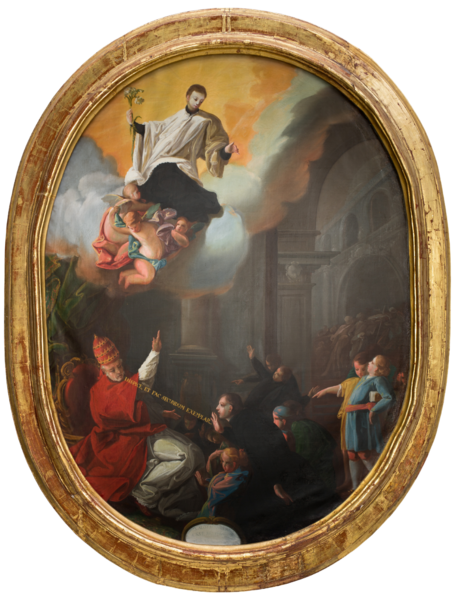- Cronología
- Ca. 1763 - 1764
- Ubicación
- Museum of Zaragoza, Zaragoza, Spain
- Dimensiones
- 127 x 88 cm
- Técnica y soporte
- Oil on canvas
- Reconocimiento de la autoría de Goya
- Attributed work
- Titular
- Jaraba Town Hall (Zaragoza)
- Ficha: realización/revisión
- 28 Dec 2009 / 30 Jun 2025
- Inventario
- en depósito
Arnaiz and Buendía have suggested that this work was located in the Seminario de Nobles (Jesuit school) belonging to the Calatayud Society of Jesus, and that following the expulsion of the order from Spain in 1767 the painting was taken to the Chapel of Nuestra Señora de Jaraba.
It was entrusted to the Museum of Zaragoza in 1985.
From December 5th, 2024, and while the Zaragoza Museum remains closed for works, the painting is part of the exhibition 'Goya. From the Museum to the Palace' in the Aljafería Palace in Zaragoza.
This oval canvas depicts the consecration of the young Aloysius Gonzaga as Patron Saint of Youth by Pope Benedict XIII. In this scene, the pontiff is addressing the faithful, pointing to the sky where we can see the saint wearing a Jesuit cassock and holding a Madonna lily, a symbol of purity. He is being carried up into the heavens by a host of angels. To reinforce the Pope's message, Goya has given him a speech scroll which reads INSPICE, ET FAC SECUNDUM EXEMPLAR ("Look, and do likewise"). In the lower part of the composition we can see a card which has been covered with white paint and inscribed with the words S. ALOYSIUS GONZA. J. A. SS. P. BENEDICTO BONUS EL EXEMPLA.
In the background we can make out the form of a temple where another scene is taking place: the burial of the saint's remains. The device of linking two episodes from the same story in the same space was very common in the baroque period.
The painting as a whole is an exaltation of the Jesuit order. The composition corresponds to baroque models, with a very marked diagonal line which divides the work into two spaces: sacred and earthly. The execution is still clumsy and severe. It is possible to detect the influence of José Luzán in the Neapolitan and Roman rococo style of certain elements such as the pastel tones employed for the clothing of the group of youths on the right.
The work is of dubious attribution, and various Goya experts do not include it in their catalogues, although others argue that this is an early work produced during the artist's training period.
-
Goya joven (1746-1776) y su entornoMuseo e Instituto Camón AznarZaragoza1986consultant editorl José Rogelio Buendía. November 21st to December 20th 1986cat. 3
-
Goya en PonceMuseo de Arte de PoncePonce1995consultant editor María Luisa Cancela Ramírez Arellano. From May 13th to September 30th 19951995
-
Goya e ItaliaMuseo de ZaragozaZaragoza2008organized by the Fundación Goya en Aragóna, consultant editor Joan Sureda Pons. From June 1st to September 15th 2008cat. 44
-
Goya. From the Museum to the PalaceZaragoza2024cat.81
-
Goya inédito en JarabaGalería AntiqvariaMadrid1985pp. 38-41
-
Goya joven (1746 – 1776) y su entornoZaragozaCaja de Ahorros y Monte de Piedad de Zaragoza, Aragón y Rioja1986p. 74, cat. 3 y lám. III
-
Goya y Aragón. Familia, amistades y encargos artísticoscol. Col. Mariano de Pano y RuataZaragozaCaja de Ahorros de la Inmaculada de Aragón1995pp. 45, 46 y p. 45 (il.)
-
Museo de Zaragoza. GuíaZaragozaGobierno de Aragón2003p. 332 and p. 333 (il.)
-
Goya e Italia, 2 vols.ZaragozaFundación Goya en Aragón y Turner2008p. 332 -333
-
Goya. From the Museum to the PalaceZaragozaZitro Comunicación2024pp.80-81
